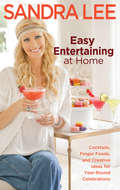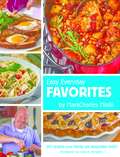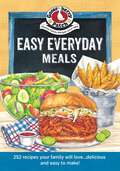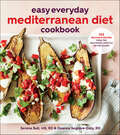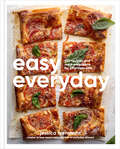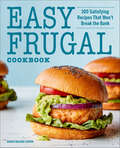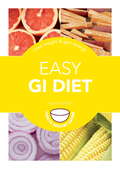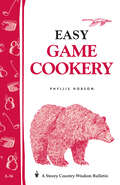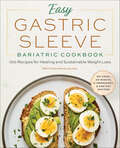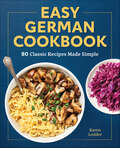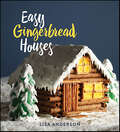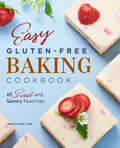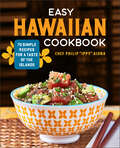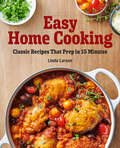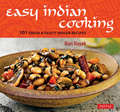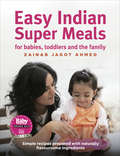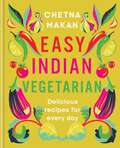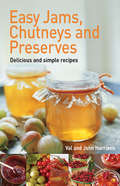- Table View
- List View
Easy Electric Smoker Cookbook: 100 Effortless Recipes for Crave-Worthy BBQ
by Marc GillMake smokehouse-quality BBQ at home with your electric smoker The electric smoker is the great equalizer between novices and pro pitmasters, making it easy for anyone to cook up a tantalizing, bacon-wrapped piece of barbecue heaven. Get the most out of your electric smoker with help from The Easy Electric Smoker Cookbook, filled with expert advice and 100 set-and-forget recipes for creating delectable barbecue in your own backyard. You'll find effortless recipes for poultry, pork, beef, fish, and seafood—plus marinades, rubs, sauces, sides, and even desserts. This beginner-friendly electric smoker cookbook includes: An intro to electric smokers—Begin with a straightforward appliance overview that includes simple instructions for firing up both chest-style and pellet electric smokers, as well as tips for safety, troubleshooting, and maintenance. Creative flavor combinations—This electric smoker cookbook teaches you how to mix and match sauces, marinades, and rubs with different meats to switch up the flavors of your barbecue. Guidance on woods—Explore the flavor profiles and characteristics of various smoking woods, and get suggestions for what cooks best with each one. A smoke-time cheat sheet—Find a handy chart that breaks down the smoking temperature, smoking time, and internal temperature for all the meats, seafoods, and veggies featured in this electric smoker cookbook. Create barbecue magic with help from The Easy Electric Smoker Cookbook.
Easy Entertaining at Home: Cocktails, Finger Foods, and Creative Ideas for Year-Round Celebrations
by Sandra LeeTelevision and cookbook star Sandra Lee offers her best ever at-home entertaining book, full of fabulous recipes and ideas for making year-round gatherings fun and simple. This month-to-month go-to guide features fast favorite cocktails and canapés for everyday entertaining, and every holiday and special occasion. In this book you will find your favorite libations and scrumptious appetizers, as well as tips for hosting a successful get-together. In Easy Entertaining at Home, Sandra Lee has created the perfect party primer and resource for the modern, busy homemaking host. The recipes include a long list of margaritas, martinis, sangrias, punches, coladas, and cosmopolitans--all your favorites are here. You'll also find savory and sweet recipes for party foods such as deviled eggs, steak skewers, sliders, jalapeno poppers, cakes, and cupcakes sure to please. Cocktails and canapés guaranteed to make stress-free at-home entertaining fast, fun, and fabulous.
Easy Everyday Favorites
by Markcharles MisilliIf you love great-tasting food that's easy to make, then you have a lot in common with MarkCharles Misilli. You're probably most familiar with MarkCharles from his appearances on QVC, where he regularly shares his no-nonsense kitchen finds and gadgets. Over the last 16 years, he's grown to become the go-to kitchen guy that America trusts. Now, MarkCharles has taken his passion for cooking and created a must-have cookbook that'll make your time in the kitchen as easy as can be. Packed with more than 150 recipes, this book is sure to have some of your all-time favorites, as well as some of your yet-to-be-discovered favorites. MarkCharles has included everything from comforting classics that are staples in his house, to decadent desserts that are bakery-worthy. And all of the recipes are made with easy-to-find, off-the-shelf ingredients, so you don't have to scramble around looking for gourmet items. As if it couldn't get any better, the "Easy Everyday Favorites" cookbook also features simple, step-by-step instructions to make your time in the kitchen a cinch! MarkCharles is a self-taught cook (with a little help from his grandmother) who likes to have fun while following his passions. He approaches cooking with the same gusto as he does when he's designing a new gadget or kitchen item. It's no wonder why his style of writing recipes is so inviting. And if you need a little help getting your taste buds even more excited, you'll love that there are lots of full-page color photos throughout the book, along with quick tips and tricks from MarkCharles. It only takes one bite to discover why these are considered "favorites. " So, whether you need to put dinner on the table for your family, or you're planning on entertaining company, you'll find that these recipes are sure to earn you a big thumbs up! Over 140 recipes as standard as meatloaf and as innovative as rice pudding crème Brûlée fill this practical, light hearted cookbook. These dishes are people pleasing with few shockers. There is ethnic food like Taco Tuesday Totchos, Taste of Tuscany Bread Salad, 7-Layer Greek Dip and German One-Pot Country Style Ribs. The whole day is covered from Southern Comfort Sausage and Biscuits for breakfast to Long Island Chicken Cutlet Sandwiches for lunch to Happy Camper Brownies or Oatmeal Cookie Sandwiches for bedtime snacks. All recipes begin with some friendly background information or mouth watering descriptions of the dish by the author. Most end with helpful tips or complementary mini recipes. Here is a recipe book all about the joy of cooking very doable recipes and the joy of eating and sharing the results by an approachable, down-to-earth home cook.
Easy Everyday Keto: Healthy Kitchen-Perfected Recipes
by America'S Test KitchenAmerica's Test Kitchen raises the bar on keto cooking with dishes that offer fantastic flavor, efficiency, and ease.Break free from the monotonous or time-consuming recipes that too often make up the reality of a keto diet and discover easier, naturally keto dishes that deliver inspiration, variety, and great taste--all while perfectly meeting your macros.In this meticulously tested, must-have collection we set our sights on regular meals anyone would enjoy, skipping the gimmicky ideas and seeking nourishing healthy fats and low-carb vegetables in recipes such as Lemon-Thyme Pork Tenderloin with Green Beans, Grilled Chicken Thighs with Shaved Zucchini Salad, One-Pan Steak Fajitas, Kimchi Beef Meatball Soup, and Green Shakshuka. Essential keto-friendly comfort foods help satisfy cravings with all-purpose keto wraps, pancakes, and simple sweets and snacks. Our recipes keep mealtime easy but interesting (most recipes take less than an hour), with plenty of variations to change up the routine (try making Butter-Basted Rib-eye Steak using Coffee-Chile Butter). Since eating outside the house is challenging, our Keto Meal Prep feature highlights the best make-and-take recipes--so you can skip that packaged snack bar and enjoy a bite of something homemade. A Keto essentials section and weekly meal plans will help to organize your shopping list, and healthy tips from our nutritionist make your goals achievable. <P><P><i>Advisory: Bookshare has learned that this book offers only partial accessibility. We have kept it in the collection because it is useful for some of our members. Benetech is actively working on projects to improve accessibility issues such as these.</i>
Easy Everyday Meals
by Gooseberry PatchIn today's fast-paced world, getting a delicious home-cooked meal on the table doesn't have to mean hours in the kitchen or complicated techniques. We have such fond memories of Mom's scrumptious meals, served up around the family dinner table. We don't know how she did it! Nowadays, balancing work, school and home-cooked meals may seem like a challenge, but we have the answer! Easy Everyday Meals features 252 new tried & true recipes shared by cooks just like you, using familiar ingredients you may already have on hand. Start the day right with a hearty warm breakfast...or how about a yummy breakfast for dinner? They'll love Creamed Chicken & Waffles, Cheesy French Toast or Skillet Hashbrowns & Ham. On chilly days, warm everyone up with Prize Chicken Chili Soup or Italian-Style Sausage Soup. Kid-friendly Cheeseburger Joes are sure to be a hit, too. Bring everyone to the dinner table with tasty, comforting dishes like Mama's Favorite Baked Spaghetti, Tamale Casserole Bake or Cheesy Chicken Delight. They'll even eat their veggies, with Stir-Fry Veggie Noodles or Mexican Squash on the menu. For game night or party time, you'll love munching on Hot Chicken Nacho Dip, Turkey Ranch Pinwheels or Dill Pickle Dip. We've even included super-easy desserts like Chocolate-Peanut Butter Cake and Southern Peach Cobbler, plus terrific tips for cooking and serving. So come on over...it's time to eat! 252 Recipes.
Easy Everyday Mediterranean Diet Cookbook: 125 Delicious Recipes from the Healthiest Lifestyle on the Planet
by Deanna Segrave-Daly Serena Ball125 all-new, easy, affordable, and delicious recipes from the bestselling authors of The 30-Minute Mediterranean Diet Cookbook.Fresh off the success of their first cookbook, The 30-Minute Mediterranean Diet Cookbook, authors Deanna Segrave-Daly, RD and Serena Ball, MS, RD, present their newest collection of 125 healthful and delicious recipes based on the Mediterranean lifestyle. Forget about fad diets and the latest trends—this book features recipes for pasta, whole grains, roasted vegetables, hearty breads dipped in olive oil, and more, all of which can be made in 30 minutes or less, and some in just twenty minutes. The recipes are budget friendly too, for anyone with a family to feed, and there are healthy kitchen hacks throughout for saving time in the kitchen. Most of the recipes are easily adaptable for gluten-free, dairy-free, egg-free, nut-free, and vegetarian lifestyles, and just like the authors’ bestselling first book, the recipes are impeccably tested by a registered dietician, and they taste great too—Greek Zucchini Pita Nachos, Broccoli-Cheese Risotto, Artichoke Cheese Strata, and more.“Deanna and Serena’s recipes are healthful and vibrant, but above all delicious. You will be amazed at how much they pack a flavor punch.” —Michael Solomonov, Chef and Co-owner of Zahav “Deanna’s and Serena’s newest cookbook is bursting with enticing recipes that are quick to fix. As a chef and dietitian, I love the foods featuring a Mediterranean diet lifestyle from a flavor and nutrition standpoint—and these recipes deliciously marry both of those concepts.” —Jackie Newgent, RDN, culinary nutritionist, award-winning cookbook writer and author of The Clean & Simple Diabetes Cookbook
Easy Everyday: 100 Recipes and Meal Prep Ideas for Effortless Eats; A Cookbook
by Jessica MerchantThe beloved blogger and author of The Pretty Dish makes meal prep simple with 100 recipes that offer what we all want: more time to enjoy a delicious meal with our loved ones.&“I&’m (selfishly) so glad Jessica Merchant has used her endless talent for creating unfussy, airtight recipes for accessible meals in a new cookbook for us because I immediately want to make everything.&”—Deb Perelman, author of Smitten Kitchen KeepersJessica Merchant, creator of the popular recipe and lifestyle site How Sweet Eats, gets asked almost every day by fans: How do I put food on the table in a way that doesn't break the bank and doesn't make me stressed and anxious? In Easy Everyday, Jessica unlocks the secret to efficiently getting meals on the table that are nutritious, delicious, creative, and low maintenance. She&’s realized that although we&’re asking for stress-free ways to cook meals, we&’re ultimately asking for a happy table, a place to create memories with our loved ones over a delicious meal. All 100 recipes keeps the reader out of the kitchen and spending more time with the people they love. Meal planning tips and tricks abound, with ingredients chosen for ease of preparation, versatility, and leftover quality. Jessica shares her ten-minute meal prep strategy to create easy, healthy, satisfying meals, lunches, and snacks to have throughout the day, such as Crispy Baked Breakfast Quesadillas, Peanut Butter Chocolate Oatmeal Cups, Cherry Jalapeno Chicken Salad, Lemon Spaghetti with Roasted Chickpeas and Cilantro Lime Sheet Pan Fajitas. Featuring gorgeous photos and helpful advice, Easy Everyday makes meal prep quick, fun, and delicious.
Easy Frugal Cookbook: 100 Satisfying Recipes That Won't Break the Bank
by Sarah Walker CaronEat well for less—100 delicious, affordable recipes the whole family will loveIt's easier than you think to make hearty meals that are tasty, budget-friendly, and nutritious. Discover an easy cookbook that shows you how, with 100 inexpensive family recipes that use basic ingredients, and can be made in just a few steps.This easy cookbook will help you whip up satisfying dishes like Crispy Coconut Drumsticks or Open-Face Turkey Sandwiches for everyone in the house for just $5. All it takes is the right recipe, a few tricks, and a little planning to make the most of your food budget.Discover how versatile and flavorful cheap eating can be with an easy cookbook that offers:Budget tricks—Recipes are sorted by estimated cost of ingredients, from $5 to $15 dollars per batch, and include tips to lower the cost of ingredients even further.Shop smart—This easy cookbook includes tips about shopping efficiently and optimizing ingredients and leftovers.Menu plan—A sample meal plan and shopping list will help simplify meal prep and save you money and time.Bring the whole family to the table with an easy cookbook that makes weeknight dinners easy and affordable.
Easy GI Diet: Use the Glycaemic Index to Lose Weight and Gain Energy
by Helen FosterDid you know that high-GI diets, while sounding healthy, can actually increase your risk of heart problems, diabetes, weight gain and possibly even some cancers? Easy Low-GI Diet focuses on healthy, low-GI foods that give you more energy, keep hunger at bay and protect against heart disease and diabetes. Inside there are four great diet plans to choose from: The Genius weight-loss planThe Vegetarian weight-loss planThe energy-boosting Galvanizer planThe GI for Life plan to maintain your new-found figurePacked with expert information on what low-GI means and how it can help, as well as the at-a-glance GI ratings chart with over 600 entries to help you choose the right foods for you, this easy-to-follow guide contains everything you need for a healthier, low-GI lifestyle.
Easy GI Diet: Use the Glycaemic Index to Lose Weight and Gain Energy
by Helen FosterDid you know that high-GI diets, while sounding healthy, can actually increase your risk of heart problems, diabetes, weight gain and possibly even some cancers? Easy Low-GI Diet focuses on healthy, low-GI foods that give you more energy, keep hunger at bay and protect against heart disease and diabetes. Inside there are four great diet plans to choose from: The Genius weight-loss planThe Vegetarian weight-loss planThe energy-boosting Galvanizer planThe GI for Life plan to maintain your new-found figurePacked with expert information on what low-GI means and how it can help, as well as the at-a-glance GI ratings chart with over 600 entries to help you choose the right foods for you, this easy-to-follow guide contains everything you need for a healthier, low-GI lifestyle.
Easy Game Cookery: Storey's Country Wisdom Bulletin A-56 (Storey Country Wisdom Bulletin Ser.)
by Phyllis HobsonSince 1973, Storey's Country Wisdom Bulletins have offered practical, hands-on instructions designed to help readers master dozens of country living skills quickly and easily. There are now more than 170 titles in this series, and their remarkable popularity reflects the common desire of country and city dwellers alike to cultivate personal independence in everyday life.
Easy Gastric Sleeve Bariatric Cookbook: 100 Recipes for Healing and Sustainable Weight Loss
by Marina Savelyeva100 Simple, delicious recipes for recovery from gastric sleeve proceduresGastric sleeve surgery, or Vertical Sleeve Gastrectomy (VSG), provides patients with the opportunity for a fresh approach to weight loss and healthier living. The Easy Gastric Sleeve Bariatric Cookbook will guide you through the process of post-op healing, provide you with the tools necessary to lose weight, and help you embrace and sustain these healthy habits for the long run.From pre-surgery prep work to a full post-op meal plan, this gastric sleeve cookbook contains 100 easy, delicious, and properly portioned recipes, from Banana Yogurt Shake to Baked Cinnamon-Apple Ricotta, made with familiar ingredients and organized by healing stage. Beyond weight loss, adopting this healthy eating plan in this gastric sleeve cookbook can also help reduce or eliminate the need for medications and ease conditions such as diabetes, sleep apnea, and high blood pressure.Inside this gastric sleeve cookbook, you'll find:A strategy for surgery—Discover a helpful overview of gastric sleeve surgery, such as what to know and expect pre- and post-op.Stage-by-stage healing—Avoid any post-op nutritional confusion with an 8-week meal plan for eating after VSG, organized by healing stage.Eating made easy—All of the recipes in this gastric sleeve cookbook are easy to make, with the vast majority of recipes requiring zero cooking, 5-ingredients or fewer, 30-minutes or fewer to make, or one pot.Let this gastric sleeve cookbook be your companion in a successful healing process and better life going forward.
Easy German Cookbook: 80 Classic Recipes Made Simple
by Karen LodderGuten Appetit! Create delicious German dishes in a snap.German cooking and baking is loved the world over for its rich, complex flavors. While these recipes have been passed down through generations, making them at home is simple with the Easy German Cookbook. Learn to prepare essential German breads, meats, stews, and sweets with straightforward recipes and directions. You'll also learn about German language and culture. Put tasty German classics on your Stammtisch with easy recipes you can create in Eins, Zwei, Drei.German cuisine made simple—Discover preparation tips and shopping tricks and shortcuts for stocking your German kitchen and preparing age-old favorites in minutes, not hours.Easy weeknight recipes—These delicious dishes are easy in at least 1 of 4 ways by requiring only 1 pot, using 5 ingredients, taking 30 minutes to prepare, or being cook-free.An intro to regional cuisine—Gain culinary and geographical knowledge about Germany's many diverse states, like Berlin's Currywurst and Southwest Germany's Black Forest Cake.Enjoy delicious German cooking with this easy cookbook.
Easy Gingerbread Houses
by Lisa AndersonBuilding a fabulous gingerbread house is quick and easy using the patterns and ideas found in Easy Gingerbread Houses. There’s no need for the messy and time-consuming tasks of mixing dough, rolling it out, baking it, and waiting for it to harden. All of the houses in this book are made using graham crackers, cookies, cereal, ice cream cones, frostings, and candy treats. For a fun family activity, create a Sweetheart Cottage, a Cozy Cabin, a Big Red Barn, a Blue Dollhouse, a Mermaid Palace, Santa’s Castle, or even a Tiki Hut.
Easy Gluten-Free Baking Cookbook: 65 Sweet and Savory Favorites
by Jessica KirkDiscover how easy gluten-free baking can be Living without gluten doesn't mean giving up the joy of fresh-baked sweet and savory treats. With this gluten-free cookbook, bakers of any experience level can enjoy the baked goods of their dreams. The straightforward guidance, familiar ingredients, and foolproof flour blends make it simple to turn out perfect pumpkin pie or corn bread warm from the oven. Apple Pie with Salted Caramel—This showstopper dessert nestles warm baked apples and homemade salted caramel sauce inside a flaky pie crust. Coffee Cake Bars—The soft bars are perfectly moist and spongy, topped with cinnamon-sugar crumble for an extra sweet crunch. Sweet Southern Corn Bread—It's just as corn bread should be: slightly sweet and slightly creamy, with the perfect golden-brown crust. There's no limit to the gluten-free treats you can bake with the help of the Easy Gluten-Free Baking Cookbook.
Easy Gluten-Free, Dairy-Free Cookbook: 75 Satisfying, Fuss-Free Recipes
by Silvana NardoneDiscover how fast and easy it is to make gluten-free, dairy-free mealsEating gluten free and dairy free can be both simple and flavorful with the right guidance. This essential cookbook introduces the busy cook to nourishing, no-hassle meals for even the most discerning palate. Recipes include healthy versions of comfort foods you love, like pizza and chili, so you never feel like you're missing out.Whether you're embarking on this healthy lifestyle because of allergies, food intolerance, or digestion issues, your body and your taste buds will thank you.This gluten-free and dairy-free cookbook features:75 enticing recipes—Delight the family with mouthwatering meals, like White Chicken Chili, Easy Margherita Pizza, and Spicy Sichuan Beef with Mixed Vegetables. And for dessert, surprise them with gluten-free, dairy-free Blackberry Cheesecake Bites and more.Easy-to-make meals—Serve up savory gluten-free, dairy-free meals in no time with recipes that call for one pot or pan, 5 main ingredients, or just 30 minutes to cook.Helpful hints—Turn your gluten-free kitchen into a well-oiled machine with time-saving tips and shopping guidance.Eat healthy and feel better with the quick and simple meals in The Easy Gluten-Free, Dairy-Free Cookbook.
Easy Hawaiian Cookbook: 70 Simple Recipes for a Taste of the Islands
by Philip "Ippy" AionaBring home the flavors of Hawai'iHawaiian food is delicious, uncomplicated, and has a long history of bringing people together. And now you can make authentic Hawaiian meals at home, no matter where home is. The Easy Hawaiian Cookbook is a friendly guide for any casual cook who wants to serve up a taste of aloha—without the airfare.Mainland tips and tricks—Learn how to replicate traditional Hawaiian dishes with simple and accessible ingredients. Did you know that cooking Kalua Pig without an earth oven is as simple as adding smoked salt and liquid hickory?Your island pantry—Find a list of ingredients and tools that no Hawaiian kitchen should be without, so you can save time and set yourself up for tasty success.The melting pot of the Pacific—Dive into the wonderful world of Hawaiian cuisine, and explore the huge range of cultures that inspired its unique and beloved staples.Transport your taste buds to Hawai'i with this easy cookbook that shows you how to recreate island classics anywhere.
Easy Home Cooking: Classic Recipes That Prep in 15 Minutes
by Linda LarsenBecome a better home cook with 100 mouthwatering recipes that require just 15 minutes of prep time Everyone knows that home cooking is the best way to save money and eat fresh, but after a long day of juggling responsibilities, it's often easier said than done. With Easy Home Cooking, you can simplify your routine and enjoy home-cooked meals packed with flavor and nutrition—easily. You'll find a tasty mix of 100 familiar favorites and creative, modern dishes—all of which take 15 minutes or less to prepare for cooking. Learn how to navigate the kitchen confidently with beginner-friendly recipes like Chicken Parmesan Sandwiches, Spiced Maple Sausage Bake, and Ravioli Lasagna that use simple, everyday ingredients you can find at your local grocery store. Who knew home cooking could be so convenient and quick? Easy Home Cooking includes: Speedy prep pointers—Discover ways to speed up food preparation time for faster home cooking, from planning ahead to learning how to use a knife efficiently. Classic & contemporary fare—Explore comfort classics with special twists, as well as contemporary dishes with creative flavor combinations. Cooking tips & tricks—Find suggestions for getting the most out of each recipe, from cooking tips to ingredient variations that step up the flavors of each dish. Create fuss-free, home-cooked meals that delight the whole family with Easy Home Cooking.
Easy Homemade Desserts with Jello Pudding
by General Foods CorporationCatalogues dozens of recipes that make use of Jello products, from casual treats, to more elegant desserts.
Easy Indian Cooking
by Jack Turkel Hari NayakIn Easy Indian Cooking, Chef Hari Nayak presents recipes for the dishes he remembers from childhood days, growing up in rural southern India. These recipes have been modified to suit a modern lifestyle, and all of them can be prepared with ingredients available at any local supermarket or health food store. The preparation and cooking techniques have been simplified to save time without sacrificing any of the authentic Indian flavor.A CIA-trained chef, Hari has put together an authentic collection of Indian favorites that are so easy to create and so flavorful you'll wonder why you never tried your hand at cooking Indian at home before!Recipes include such favorites as:- Curry Corn Chowder with Roasted Poblanos- Basil-infused Crispy Pan Fried Shrimp with Tamarind Glaze- Lemon Sage Tandoori Chicken Tikka- Cumin Coriander Beef Burger with Plum Tomato Mustard Dip- Flamed Crispy Pappadam Chips- Sparkling Ginger Lime Cooler- Cardamom Brownies
Easy Indian Cooking
by Jack Turkel Hari NayakIn Easy Indian Cooking, Chef Hari Nayak presents recipes for the dishes he remembers from childhood days, growing up in rural southern India. From curries to desserts, these recipes have been modified to suit a modern lifestyle, and all of them can be prepared with ingredients available at any local supermarket or health food store. The preparation and cooking techniques in this cookbook have been simplified to save time without sacrificing any of the authentic Indian flavor.A CIA-trained chef, Hari has put together an authentic collection of Indian favorites that are so easy to create and so flavorful you'll wonder why you never tried your hand at cooking Indian at home before!Recipes include such favorites as:Curry Corn Chowder with Roasted PoblanosBasil-infused Crispy Pan Fried Shrimp with Tamarind GlazeLemon Sage Tandoori Chicken TikkaCumin Coriander Beef Burger with Plum Tomato Mustard DipFlamed Crispy Pappadam ChipsSparkling Ginger Lime CoolerCardamom Brownies
Easy Indian Super Meals for babies, toddlers and the family: New And Updated Edition
by Zainab Jagot AhmedEasy Indian Vegetarian: Delicious recipes for every day
by Chetna Makan'Sometimes you can just pick up a book, flick through it, and know that it's going to become a constant kitchen companion...Her recipes work and, more, are reliable purveyors of delight.' Nigella LawsonCelebrating the incredible vegetarian food that India has to offer, Easy Indian Vegetarian delivers fresh, authentic Indian food for every day. You will find recipes for every occasion, with everyday ingredients and easy-to-follow instructions to help take the fuss out of dinner time. CHAPTERSSnacks: including Tomato chaat; Mango slaw; Chilli pakoraVeg: including Yogurt onion curry; Papad courgette kadhi; Rainbow chard & pea sabziDal: including Black dal; Chana dal; Chickpea yogurt curryFlatbreads: including Onion paratha; Rice dosa; Masala puriRice: including Vegetable & chickpea biryani; Green ginger pulao; Yogurt riceSides: including Sugar snap peas raita; Roast cauliflower raita; Coriander ginger chutneySweet: including Balushahi; Jaggery treat; Coconut barfiWhether you want an easy weeknight supper or a showstopping Indian feast for friends and family, with 10 suggested menu plans and a whole host of inspiring dishes to try, it has never been easier to discover the world of vegetarian flavour that will delight veggies and meat eaters alike.
Easy Indian Vegetarian: Delicious recipes for every day
by Chetna Makan'Sometimes you can just pick up a book, flick through it, and know that it's going to become a constant kitchen companion...Her recipes work and, more, are reliable purveyors of delight.' Nigella LawsonCelebrating the incredible vegetarian food that India has to offer, Easy Indian Vegetarian delivers fresh, authentic Indian food for every day. You will find recipes for every occasion, with everyday ingredients and easy-to-follow instructions to help take the fuss out of dinner time. CHAPTERSSnacks: including Tomato chaat; Mango slaw; Chilli pakoraVeg: including Yogurt onion curry; Papad courgette kadhi; Rainbow chard & pea sabziDal: including Black dal; Chana dal; Chickpea yogurt curryFlatbreads: including Onion paratha; Rice dosa; Masala puriRice: including Vegetable & chickpea biryani; Green ginger pulao; Yogurt riceSides: including Sugar snap peas raita; Roast cauliflower raita; Coriander ginger chutneySweet: including Balushahi; Jaggery treat; Coconut barfiWhether you want an easy weeknight supper or a showstopping Indian feast for friends and family, with 10 suggested menu plans and a whole host of inspiring dishes to try, it has never been easier to discover the world of vegetarian flavour that will delight veggies and meat eaters alike.
Easy Jams, Chutneys and Preserves
by John Harrison Val HarrisonThis book explains all you need to know to make your own delicious jams, jellies, marmalades, fruit butters, fruit cheeses, chutneys and pickles, including details of all the necessary equipment, how to choose the best fruit and vegetables to use, and how to make sure the jam sets properly to produce the best results.In these straitened times, more and more people are keen to save money by making jams, jellies and chutneys from the surplus of their own homegrown fruit and vegetables or from free fruit, such as blackberries, available in nearby hedgerows. Val and John Harrison show how easy it is to collect together the required ingredients and start making your own produce.

